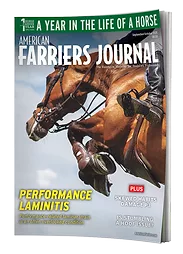This year marks the 50th anniversary (and 32nd year at Lessiter Media) of American Farriers Journal covering the farrier trade. We’re asking hoof-care professionals for a few words to include in a “From the Audience” section of our coverage – in the December edition.
International Equine Veterinarian Hall of Famer Dick Mansmann, VMD, PhD, of Chapel Hill, N.C., shares his thoughts on the hoof-care milestones over the past half-century.
These 50 years have been the golden era to have lived in. The sporting horses have come up and hopefully are not going away. But we all as a profession need to be vigilant. Social License to Operate (SLO) is heavy on our doorstep.
Q. When you look back at the last 50 years of new technologies, what were the biggest defining moments that forever changed farriery and equine health as we know it today?
A. When I first learned from farrier Martin Kelly as a child and then Jack Anderson and Charlie Humphreus as a school of veterinary medicine student and then intern, it was about forging steel shoe modifications in the fire with or without a leather pad for the horse’s needs. Over the past 50-plus years, there have been a myriad of glues, pads and shoes ready for an inquisitive farrier and/or veterinary team to use. The role of hoof mechanics in sound performing horses and in lame horses is in daily use.
Q. For the newer generation, what are the biggest ways that farriery and equine health is totally different from that of 50 years ago?
A. Beginning with Ric and Nancy Redden’s Bluegrass Laminitis Symposium, farriers and veterinarians began learning together at professional medical meetings about horse (hoof) disease(s) and mechanical and medical ways to treat them. Now, there are many joint professional opportunities for each profession to learn side-by-side. Now, some veterinarians are farriers advancing at a tertiary level the combination of medical and mechanical treatment of equine lameness. Farriers referring to more advanced skilled farriers will be the future since no one farrier now can know the needs of all horses (the way it was 50 years ago).
Q. What are some specific ways that American Farriers Journal magazine impacted your business and staff?
A. The AFJ, including the International Hoof-Care Summit, has been a major player through education bringing all these advances forward to farriers, veterinarians and owners. “No hoof no horse” as a farrier or a veterinarian you must believe.
Professionals from around the world share their insights into the important milestones, innovations and the role American Farriers Journal has played over the last half-century.
Read essays from...
- Bob Smith
- Stuart Muir
- Mike Lessiter
- Heidi Larrabee
- Esco Buff
- Walt Taylor
- Simon Curtis
- Renate Weller
- Kit Miller
- Steve Kraus
- James Orsini
- Connor Sloman
- Cody Ovnicek
- Bill Everitt
- Mel Jones
- Dick Mansmann
- Brian Rusnak
- Pat Tearney
- Doug Butler
- Joanne Volkert
- Virgil Gluth
- Gretchen Cardoso
- Kim Otterson
- Brian Hyodo







